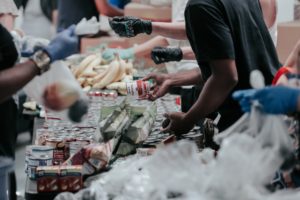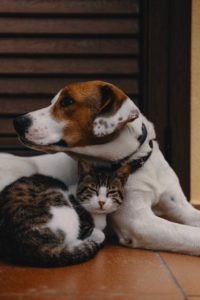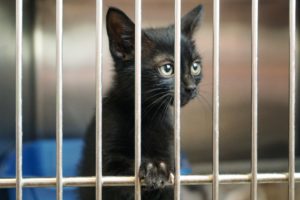Surprising Pandemic Success for Nonprofits: Vol. 2
Published on April 9, 2022, at 8:23 p.m.
by Alice Helms.
Nonprofits such as the Tuscaloosa Metro Animal Shelter, in Tuscaloosa, Alabama, and the Houston Food Bank in Houston, Texas, reach out and offer support when communities suffer, two qualities that make nonprofits successful, as noted by Forbes. The communication teams for both of these nonprofits continue to experience success with communication strategies and public relations efforts while working around challenges in the ever-changing pandemic world.
Houston Food Bank
Adele Brady, director of marketing and communications for Houston Food Bank, began her journey with the nonprofit in 2007. The food bank’s effort to grow its communications team benefits its public relations efforts with stakeholders and paid media management. Starting with a communications department comprised of Brady and the chief communication officer, Brady noted that her path within the organization has taught her to wear different hats and developed her ability to be flexible on any given day.

Her work with the communications department has led “people to know to support us [Houston Food Bank] because of our communication strategies.” In addition, her team focuses on brand awareness. “Everything we touch, our activities support our organization,” including the Houston Food Bank website, stated Brady.
Using the nonprofit’s website metrics, Brady said she was able to track the traffic to the website during the pandemic. The reach for the organization began to grow with its easily accessible tools on the website and content that was easy to read and navigate, she explained.
The food bank’s successful communication efforts were the beginning of its pandemic response success. The “silver lining” includes a partnership with American Air and a visit from Alexandria Ocasio-Cortez, a United States representative for New York’s 14 congressional district since 2019 who donated nearly $3 million to the nonprofit. Houston Food Bank was also granted a visit from President Biden and First Lady Dr. Biden due to the hard work the food bank did during the most recent winter storm.
According to Brady, to evaluate the communication efforts for the organization, the staff “look at metrics for their media ad value and social media, including listening, engagement and reach.” She also said that the organization watches for what drives spikes on its website — new stories, events, etc.
As a nonprofit that relies on its volunteers, Houston Food Bank understands that “people want to know that what they are doing is helping — either financially or through time spent volunteering — [and that] the benefits are immediate,” Brady said. She explained, “Based on [volunteers’] time served, at the end of the shift, they know how many meals they helped provide. We have worked on calculating the financial impact, and with resources, it is one meal per dollar donated and around one meal per volunteer hour of volunteer work.”
During the pandemic, Brady noted, the media quickly wrote about health and food insecurity as front news coverage. She explained, “So many jobs and hours were cut, the reality [was] that everyone could be affected.” From Brady’s experience, communities began to show up and support the Houston Food Bank and surrounding areas.
Brady recalled after Hurricane Harvey when Louisiana came to Houston’s rescue, the media became very interested in neighboring states helping each other. “And it felt special to reciprocate support when needed after Hurricane Ida hit Louisiana,” she said. Brady stated that “I even ran into New Orleans’ residents, who spent 24 hours evacuating to Houston from Hurricane Ida, volunteering at the Houston Food Bank because they wanted to give back, because the storm or pandemic could hit anyone — [and] because we are ‘neighbors in the Gulf Coast.’ That really moved me.”
When the pandemic began, Brady remembers that “the cars lined up. People were waiting for a long time to get food. We were all trying to have an uplifting spirit, and from people waiting in lines for food to the volunteers — we were all in this together. The National Guard even showed up to help us. People came out in forces to help others.”
Tuscaloosa Metro Animal Shelter
Catherine Moore, Tuscaloosa Metro Animal Shelter’s office and programs team lead, began her work with the nonprofit as a front lobby receptionist in February 2021. For shelter operations, Moore said that “COVID was still such a prominent and scary subject for the world, and here at the shelter, we had some rules based on CDC guidelines. So initially, we were not allowed public access to the shelter whatsoever and relied on Zoom for adoptions and such.”

Moore noted that her communication strategies have positively impacted the organization during her time with the shelter. She stated, “I feel like my work here at the shelter has contributed to the success, because I have worked so hard to improve our social media presence and grow followers and awareness online while I’ve been here. Social media is such a huge way to spread the word and get awareness out there for the animals here, and it has helped so much!”
Her ability to grow the organization’s key publics relies on a strategy of “spreading the word through social media,” which she noted “has probably been the most successful way we’ve grown during the pandemic.” Moore stated that, along with the shelter’s social media success, “about two years ago we were blessed with getting a whole new building full of office spaces, including adoption rooms, volunteer and foster offices, kennels and cages for the animals, and storage space for food.” She added, “We are so very grateful for the help we receive from the community; we couldn’t do it without them.”
Regarding the shelter’s success in maintaining stakeholder relationships amidst the pandemic, Moore said, “I think the most encouraging thing for donors is to see the reality of the situation and where their help is needed. We always try to be truthful when asking and reaching out for help from the community. So often, it is for sick or injured animals that we need help with their vet bills and care, and it certainly helps to post pictures and the stories of those animals, so the community truly sees who they are helping.”
As a large part of the organization’s successful public relations efforts in the past two years, Moore and other shelter staff have worked hard to grow the organization’s community reach. She explained, “We help host Pet Pantries each month where we hand out pet food to those in need, offering other resources to the community for rehoming, spay/neuter, community service work, and more.” Moore noted how the organization strives “to make a difference in these animals’ lives” while also having “an impact in the community for animal welfare.”

As local nonprofits, Houston Food Bank and Tuscaloosa Metro Animal Shelter work closely with their communication teams to achieve constant growth amidst an ever-changing and post-pandemic world while continuing their missions.




